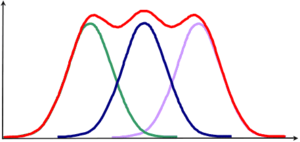Stratified sampling examples
From AWF-Wiki
(Difference between revisions)
(→Example 1) |
(→Example 1) |
||
| Line 1: | Line 1: | ||
===Example 1=== | ===Example 1=== | ||
| − | [[File:5.2.6-fig74.png|right|thumb| | + | [[File:5.2.6-fig74.png|right|thumb|300px|Illustration why stratification is most efficient when the ''strata means'' are as different as possible]] |
Imagine the example population of <math>N=30</math> elements be subdivided into three strata as in the figure on the right. Here, stratification has been done arbitrarily into three strata of size 14, 8 and 8. | Imagine the example population of <math>N=30</math> elements be subdivided into three strata as in the figure on the right. Here, stratification has been done arbitrarily into three strata of size 14, 8 and 8. | ||
Revision as of 18:32, 16 December 2010
Example 1
Imagine the example population of \(N=30\) elements be subdivided into three strata as in the figure on the right. Here, stratification has been done arbitrarily into three strata of size 14, 8 and 8.
From this stratified population, we wish to take a sample of \(n=10\), taking \(n_1=4\) from the first stratum and \(n_2=n_3=3\) from the other two strata. The stratum parametric means and variances are given in Table 1.
Table 1: Stratum parameters for the stratified example population.
Stratum \(N_h\,\) \(n_h\,\) \(\mu_h\,\) \(\sigma_h^2\,\) 1 14 4 6.29 3.49 2 8 3 10.13 4.86 3 8 3 5.38 2.48
sorry: This section is still under construction! This article was last modified on 12/16/2010. If you have comments please use the Discussion page or contribute to the article!
